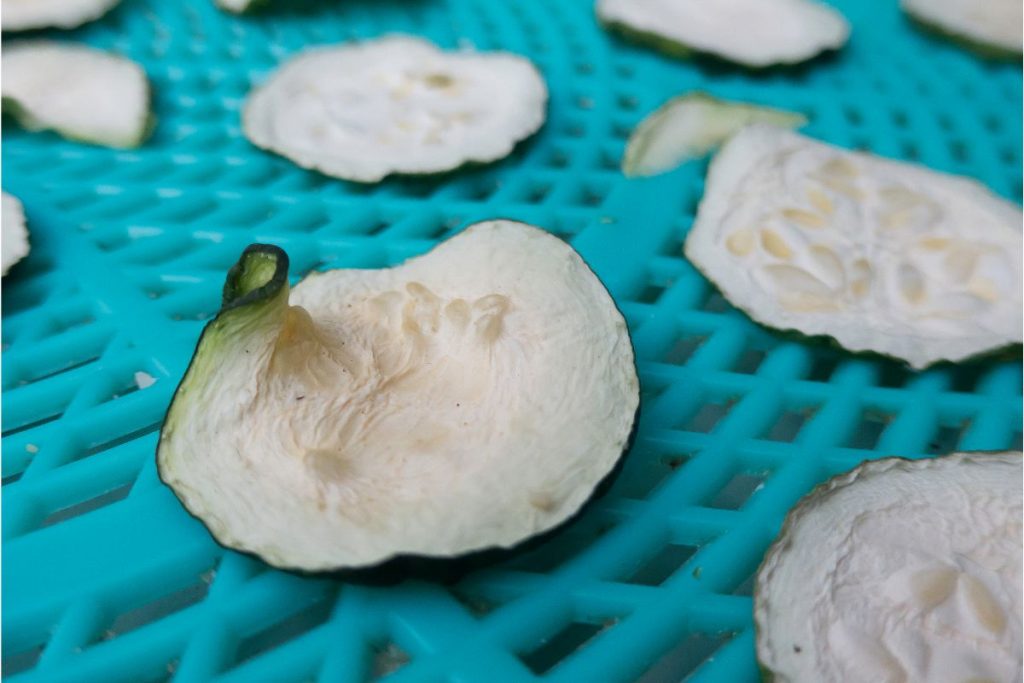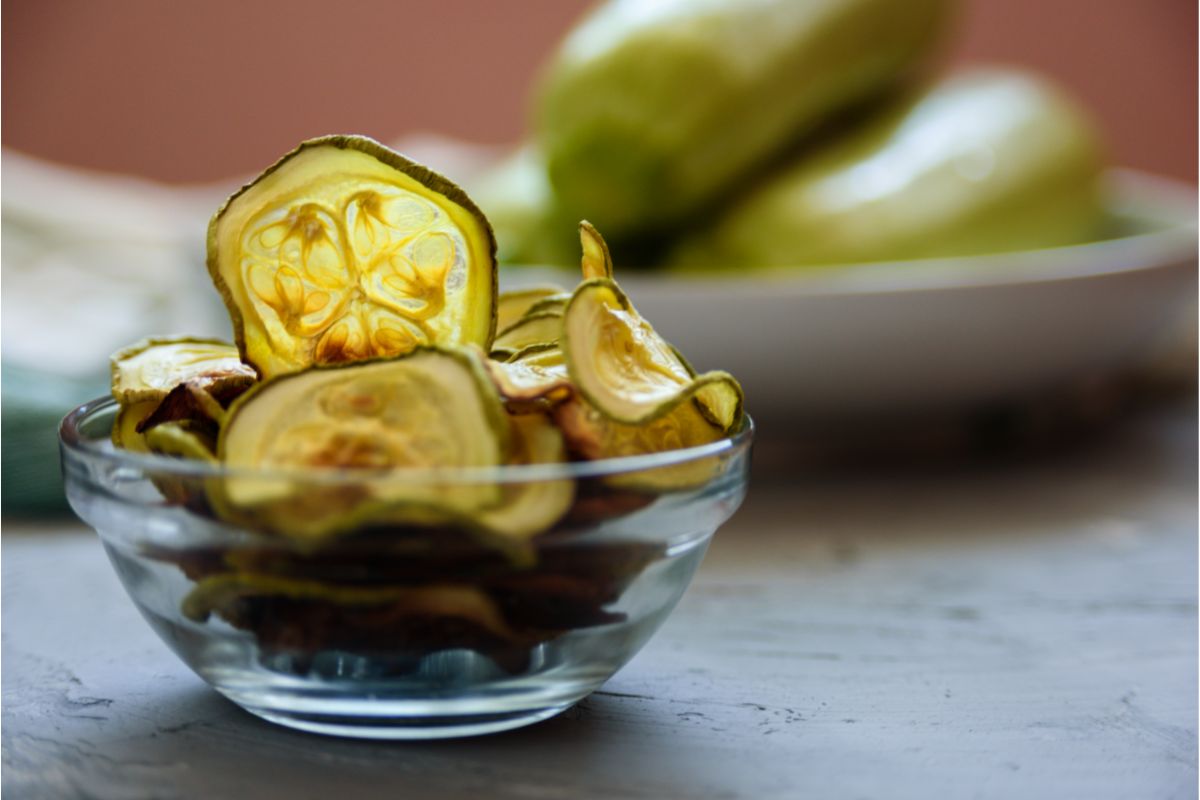To make dehydrated zucchini, wash and chop the vegetables into 1/4-inch slices. Blanch and dry the pieces before placing them in a single layer on a dehydrator tray. Dehydrate at 125˚F for 5-11 hours. Once dry, allow them to cool to room temperature, and then store in an airtight container.
Table of Contents
How to Make Dehydrated Zucchini in a Food Dehydrator
The easiest way to make dried zucchini is by using a food dehydrator. This method also works for other veggies in the summer squash family, including cucumber.
- Wash your zucchini under cool, running water. Chop off the ends, and cut the fresh zucchini into 1/2-inch zucchini slices.
- Blanch the zucchini pieces, then dry the zucchini with a paper towel.
- Lay out the zucchini slices on a dehydrator tray, arranging them in a single layer. Leave space between the pieces to allow for proper airflow.
- Set the food dehydrator temperature to 125˚F, and place loaded trays inside.
- Allow the zucchini to dehydrate for 5-11 hours. Large zucchini slices will take longer to dehydrate.
- Check regularly, taking pieces out of the dehydrator to see how far along they are. When the zucchini is fully dry, it will be crispy and brittle.
- Remove the zucchini pieces from the dehydrator and allow them to cool to room temperature.
- Once cool, store the zucchini in an airtight container or vacuum seal bag in a cool, dark, dry place for long-term storage.

How to Dehydrate Zucchini in an Oven
If you don’t have a food dehydrator, you can dehydrate zucchini in an oven.
- Wash and cut the zucchini into thin slices, removing the ends. Blanch, cool, and dry the zucchini pieces.
- Line a baking sheet with parchment paper and arrange your zucchini slices on it in a single layer.
- Preheat the oven to 150˚F or the lowest temperature setting.
- Place the baking sheet in the oven on the center shelf. Prop open the oven door with a wooden spoon to allow humidity to escape.
- Allow the zucchini to dry for 2-5 hours. If you have multiple baking sheets of zucchini, move them around the oven at regular intervals to ensure even drying.
- Check regularly, removing the zucchini when it is dry and brittle.
- Remove from the oven, allow to cool, and then store in labeled, airtight containers.
Different Ways of Cutting Zucchini for Dehydrating
Zucchini is a versatile veggie. You can use dried zucchini in different zucchini recipes just by slicing it in different ways.
1. Zucchini Chips
Dehydrated zucchini chips are made by cutting your vegetable into 1/4-inch slices using a mandoline slicer or knife.
Once dried, season the chips with a little salt, garlic powder, or onion powder. Crispy zucchini chips offer a gluten-free, keto-friendly alternative to potato chips.
2. Zucchini Shreds
Zucchini shreds are useful for adding to soups or stews and are used for increasing the moisture in baked goods, such as zucchini bread.
To make zucchini shreds, shred the vegetable with a box or cheese grater. Zucchini shreds will dehydrate quicker than larger pieces, with minimal prep time!
3. Zucchini Cubes
Zucchini cubes are the best option for casseroles. They can also be powdered down into zucchini powder in a food processor in minutes. To make zucchini cubes, dice the zucchini into small, square shapes instead of slicing them into rounds.
4. Zucchini Noodles (Zoodles)
Zucchini noodles are an alternative to pasta that helps you cut down on carbohydrates! This low-carb option can be made using a spiralizer.
When drying the zoodles, arrange them in little nests rather than laying them out in individual strands. Dehydrated zoodles are a great option for making instant meals.

How Much Does Zucchini Shrink When Dehydrated?
Zucchini will shrink in size 25% when dehydrated. The dehydration process removes the moisture content of the vegetable. Zucchini has an extremely high water content, so it shrinks down a lot.
Why Blanch Zucchini Before Drying It?
Blanching is recommended for dehydrating zucchini. Blanching is the process of submerging the vegetable in boiling water for a couple of minutes before setting it into ice-cold water to stop it from cooking.
Blanching inhibits the enzyme processes within the vegetable that cause discoloration and loss of flavor over time.
Can You Dehydrate Raw Zucchini?
Yes, you can dehydrate raw zucchini though it is recommended that you blanch zucchini before drying it.

What are the Benefits of Dehydrated Zucchini?
Dehydrating zucchini increases its shelf life while making it safe to store at room temperature. Dried zucchini weighs less than fresh zucchini and is a great addition to backpacking meals.
Zucchini is a veggie with a number of health benefits. It is rich in nutrients, including magnesium, potassium, vitamin C, and vitamin A. It is also high in antioxidants and fiber while being low in calories.
How Long Does it Take to Dehydrate Zucchini?
If using a food dehydrator, it takes between 5 and 11 hours to fully dry zucchini. It takes 2-5 hours to dehydrate in an oven.

What is the Best Way to Rehydrate Dehydrated Zucchini?
The best way to rehydrate zucchini is to place it in a bowl and cover it with boiling water.
Allow the zucchini to soak for 30 minutes. It will expand in size and become a more vibrant green color. Once rehydrated, zucchini can be cooked.
How Long Will Dehydrated Zucchini Last?
Dried zucchini has a shelf life of 1 year. For the best flavor, use it within 6 to 8 months.
What is the Best Way to Store Dehydrated Zucchini?
The best way to store dehydrated zucchini is in an airtight container, such as a Mason jar, Kilner jar, or canning jar. Moisture, heat, and light will reduce the shelf life of zucchini, so keep the containers in a cool, dark, and dry place such as a pantry.

